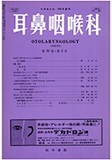Japanese
English
- 有料閲覧
- Abstract 文献概要
- 1ページ目 Look Inside
I.はじめに
鼻出血の大部分は,キーゼルバッハ氏部位からの出血であり,各種疾患による出血性素因を持つ患者を除けば,比較的容易に止血し得る場合が多い。しかるに,鼻腔深部からの大量出血で,出血部位の確認が不可能な例に遭遇することがある。このような場合,翼口蓋動脈や前(後)篇骨動脈領域からの出血,内頸動脈瘤または頸動脈―海綿静脈洞瘻(C-C-fistel)破裂による出血などを考えなければならない。かかる症例に対する止血処置は困難をきわめ,長期間にわたるタンポン挿入や,手術的止血法として,外頸動脈結紮,経上顎洞的に翼口蓋窩を開放し,選択的にa. maxillarisを結紮するSeiffert法などがとられている。
今回われわれは,頭部顔面外傷直後からの大量鼻出血例で,タンポン除去が不可能であつた症例を経験した。この例に対し,内頸および外頸動脈血管造影を行ない,翼口蓋動脈からの出血であることを確認し得た。さらにここにカテーテルを選択的に挿入して,gelfoamの注入によりsuperselective arteriographic embolizationをはかり完全に止血し得たので,この症例の経過を報告するとともに,本法の有用性について述べ,諸賢のご批判をあおぎたいと思う。
A case of nasal hemorrhage following a trauma caused by traffic accident with a difficult hemostasis is reported. A dramatic hemostatic effect was obtained in this case with a new hemostatic technique that consisted of creating on the damaged vessel an artificial embolus of superselective artereographic embolization.
A detailed description of the technical aspects of this new method is reported. Referrence is made of the related literature. And it is suggested that the method may be advantageously employed in the field of brain surgery.

Copyright © 1978, Igaku-Shoin Ltd. All rights reserved.


